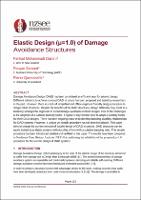| dc.contributor.author | Darani, Farhad M. | |
| dc.contributor.author | Zarnani, Pouyan | |
| dc.contributor.author | Quenneville, Pierre | |
| dc.date.accessioned | 2023-02-21T01:18:16Z | |
| dc.date.available | 2023-02-21T01:18:16Z | |
| dc.date.issued | 2022-04-27 | |
| dc.identifier.uri | https://repo.nzsee.org.nz/xmlui/handle/nzsee/2503 | |
| dc.description.abstract | Damage Avoidance Design (DAD) has been considered an efficient way for seismic design. Different solutions to achieve a robust DAD structure has been proposed and tested by researchers in the past. However, there is a lack of simplified and office-engineer friendly design procedure to design DAD structures. Despite the benefits of the DAD structures, design difficulty may result in a tendency amongst the engineers to avoid damage avoidance in their designs. One of the challenges is the adoption of a suitable ductility factor. Engineers may wonder how to adopt a ductility factor for their DAD designs. There has been ongoing research to develop damping-ductility relationships for DAD systems. However, a unique yet simple procedure has not been introduced. This paper aims to change the current mindset of ductile design of DAD structures. DAD structures can be easily looked at as elastic systems with ductility of one with a suitable damping ratio. This simple procedure has been introduced, studied and verified in this paper. The results have been compared to Nonlinear Time History Analysis (NLTHA) confirming the reliability of the proposed μ=1.0 procedure for the seismic design of DAD systems. | |
| dc.language.iso | en | |
| dc.publisher | New Zealand Society for Earthquake Engineering | |
| dc.relation.ispartofseries | 2022;123 | |
| dc.subject | Advancements in structural and geotechnical design and assessment | |
| dc.title | Elastic Design (μ=1.0) of Damage Avoidance Structures | |
| dc.type | Article | |

